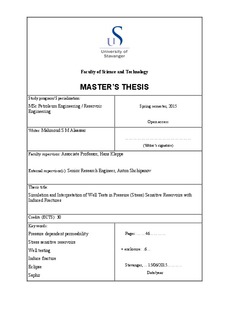| dc.contributor.author | Alaassar, Mahmoud | |
| dc.date.accessioned | 2015-09-21T12:37:46Z | |
| dc.date.available | 2015-09-21T12:37:46Z | |
| dc.date.issued | 2015-06-15 | |
| dc.identifier.uri | http://hdl.handle.net/11250/300915 | |
| dc.description | Master's thesis in Petroleum engineering | nb_NO |
| dc.description.abstract | In the petroleum industry pressure (stress) dependent permeability is usually not considered in reservoir simulations. It’s often due to lack of laboratory and field data, which determines the level of pressure (stress) dependency. Neglecting pressure (stress) dependency in a reservoir model may cause troubles in history matching and reduce forecast capability. This study focuses on numerical simulation of well test responses for pressure (stress) sensitive formations and interpretation of these responses with analytical models. The goal is to show the value of conventional well testing theory in estimating characteristics of stress-‐sensitive reservoirs.
Generally, a stress-‐sensitive reservoir may be addressed in coupled simulation of fluid flow and geomechanics where the reservoir properties i.e. permeability are considered as stress-dependent. However, in a conventional reservoir simulation workflow (only fluid flow) these properties may be considered as pressure-‐dependent. In principle, permeability is a function of effective stress, but in practice a function of pressure may be used as a simplifying assumption. The thesis investigates dynamic permeability change as a function of pressure in stress-‐sensitive reservoirs using a conventional reservoir model. The simulations include hydraulic fracture and non-‐fractured formation. Induced fractures have a strong impact on fluid flow in formations, governing flow paths and sweep efficiency. It was assumed that the numerical simulations provide synthetic well test responses that represent real pressure measurements from a field.
Analytical solutions based on the permeability modulus concept have been suggested in the literature to analyze pressure transient tests in pressure (stress) sensitive reservoirs. This concept is also widely used to approximate results of laboratory studies. Using the concept of permeability modulus, the study presents numerical simulations for pressure sensitive reservoirs. Pressure transients with impact of permeability modulus, fractures and outer boundary effects have been numerically studied in detail. A step-‐rate test in an aquifer was numerically simulated to assist in determining the pressure dependent permeability. The numerical well test responses obtained with constant and pressure dependent permeability were combined with the analytical model responses generated by the well-test software where single-phase flow and constant reservoir properties are assumed.
Finally, the synthetic step rate test response resulted from numerical simulation of pressure sensitive reservoir was interpreted step-‐by-‐step using analytical models conventionally used in pressure transient analysis. The possibility to estimate correct permeability dependence on pressure using the analytical step-‐by-‐step interpretation was confirmed. It was shown that the pressure dependent permeability curve (permeability modulus) may be constructed from the interpreted permeability values. Therefore, this step-‐by-‐step interpretation approach may be used to estimate pressure dependent permeability for pressure (stress) sensitive reservoirs from actual field data. | nb_NO |
| dc.language.iso | eng | nb_NO |
| dc.publisher | University of Stavanger, Norway | nb_NO |
| dc.relation.ispartofseries | Masteroppgave/UIS-TN-IPT/2015; | |
| dc.rights | CC0 1.0 Universal | * |
| dc.rights.uri | http://creativecommons.org/publicdomain/zero/1.0/ | * |
| dc.subject | petroleumsteknologi | nb_NO |
| dc.subject | petroleum engineering | nb_NO |
| dc.subject | Saphir | nb_NO |
| dc.subject | reservoarteknologi | nb_NO |
| dc.subject | pressure dependent permeability | nb_NO |
| dc.subject | stress sensitive reservoirs | nb_NO |
| dc.subject | well testing | nb_NO |
| dc.subject | induce fracture | nb_NO |
| dc.subject | eclipse | nb_NO |
| dc.title | Simulation and interpretation of well tests in pressure (stress) sensitive reservoirs with induced fractures | nb_NO |
| dc.type | Master thesis | nb_NO |
| dc.subject.nsi | VDP::Technology: 500::Rock and petroleum disciplines: 510::Petroleum engineering: 512 | nb_NO |

